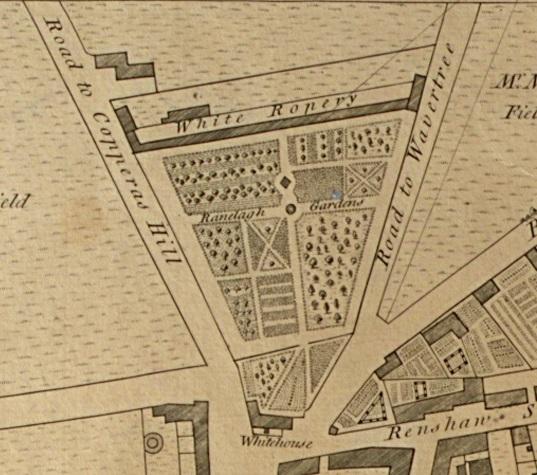Pleasure Gardens Past

Today we have a guest blog from Rebecca Metcalfe, a volunteer working on the Galkoff's and Secret Life of Pembroke Place project, supported by the Heritage Lottery Fund. Rebecca has been researching historical open spaces in Liverpool, and discovered a lot about Ranelagh Gardens. "Ranelagh Gardens was not something I was aware of prior to volunteering with the ‘Galkoff’s and Secret Life of Pembroke Place’ project, but its history ended up being one of my main areas of research.

Ranelagh Gardens were pleasure gardens that opened in the 1720s and were modelled on a fashionable gardens of the same name in Chelsea, London. The Liverpool Ranelagh Gardens were located at the top of Ranelagh Street, the street taking its name from the Gardens, and the entrance to them was where the Adelphi Hotel stands today. The gardens stretched back quite a distance towards Brownlow Hill and Russell Street and at that time this was on the edge of Liverpool.
When researching the gardens through newspaper and advertisement archives, much of what I found was about the Ranelagh Gardens in London as opposed to its Liverpool counterpart, and most the sources I did find weren’t from when the gardens were in operation, but were sources written after the gardens closed in the 1790s. There was a particularly large amount of 19th-century sources about the gardens: a lot of information came from Victorian history journals or articles reminiscing about Liverpool’s past. One of these was an article written by James Stonehouse in the 1850s. He describes what the gardens were like, and says that:
The gardens were laid out very tastefully, with an abundance of flowers and shrubs. In different parts were alcoves, or arbours, for the reception of company, in which refreshments were supplied. In the centre of the gardens there, was a large fish-pond, in which were great numbers of carp, tench, and other fish. The gardens were a favourite resort of ladies in the afternoon, when the fish were fed by the fair visitors, much amusement being created by the struggles of the finny tribe to secure whatever was thrown to them. Near the fish-pond was an orchestra, wherein a hand of music played constantly during the evenings. At the close of the evening a display of fire-works occasionally took place
This image of the gardens as something quiet and refined for leisure and entertainment is something that appears in all of the sources I found. There was an entry fee for the gardens, so it was something aimed at those wealthy enough to be able to afford to go. The gardens can therefore be seen as somewhere Liverpool’s metropolitan residents could go to present themselves to society as civilised, fashionable and important.
With regards to the concerts at Ranelagh Gardens, a book of music from the time lists a piece called “Susannah” by the composer Handel. The book says that this was “Sung by Mr Brett, at Ranelagh Gardens at Liverpool”, which gives a small idea of the type of concerts that took place. Another Victorian source on the gardens is a book about Liverpool written in 1849 by Thomas Kaye. In this, Kaye says there were a large number of people who worked at Ranelagh Gardens, the head of which was a man called Gibson, who ran the gardens for at least 35 years. Kaye also names the musical director as a Mr Clitheroe, who Kaye also describes as “firework maker to the Duke of York” which is one of the best job titles I’ve ever heard. Kaye also mentions an unnamed Italian as playing a significant role in the running of the gardens and a man named Jolley, who Kaye describes as “an amateur”.
I spent quite a lot of time during the project looking for traces of these people. Ranelagh Gardens closed before census records began, so this was difficult and I found no trace of any of them in any of the Liverpool Street directories from the 18th century, so although I found out some very interesting things about the gardens, it is a part of Liverpool’s history that still carries a great deal of mystery.'
References
Kaye, Thomas, The stranger in Liverpool, or, An historical and descriptive view of the Town of Liverpool and its environs (Printed in Liverpool, 1849)
Sadler, John, Apollo's cabinet: or the muses delight. An accurate collection of English and Italian songs, cantatas and duetts, set to music for the harpsichord, violin, German-Flute, &c. (Printed at Harrington Street, Liverpool: 1757)
Stonehouse, James, ‘Dramatic Places of Amusement in Liverpool A Century Ago’, in, ‘The Historic Society of Lancashire and Cheshire Journal Archive (Vol 5, 1852-1953)
